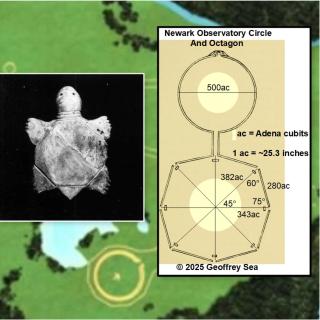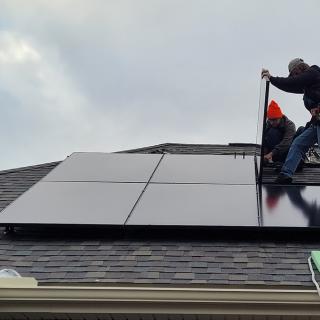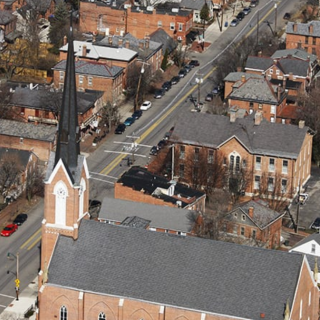Ohio is one of three states which allows the owners of private property to do as they please with human remains if dug up during construction on their property, according to the Ohio Archeological Council. Couple that with the construction boom across Central Ohio, and Ohio-based Native American activists are increasingly worried about the continuing desecration of their ancestors.
Cranes and construction equipment these days are seemingly everywhere in Columbus and surrounding counties. Rising out of the excavated dirt are apartments, roads, data centers, and everything in between. Just east of Columbus in Licking County – home to the Native American earthworks that became Ohio’s first World Heritage site – the “Silicon Heartland” is slowly being built by Intel and others.
What pre-Columbian history tells us is that Central Ohio was home to a substantial Native American community for 10,000 years if not longer before the white man arrived. The Scioto River Valley may have evolved into an empire of sorts, even though research suggests they had no authoritarian ruler. They were the “Moundbuilders,” also known as the Hopewell and Adena, and many of today’s Midwestern tribes claim ancestry.
Before and during the rise of Christianity, the Moundbuilders constructed massive archaeoastronomical earthworks, such as the Octagon, which is a 40-minute drive east of Columbus, and named a World Heritage site in 2023. Hundreds of geometric structures and mounds existed throughout Franklin County, as well. Hence “Mound Street” where a 40-foot tall, 300-foot-wide mound stood near Mound and High. Still standing today is Shrum Mound on McKinley Avenue, a conical-shaped burial mound and one of a handful spared from the farmer’s plow or modern-day development.
More tangible proof of how entrenched Native Americans were locally is what an official from the Ohio History Connection told the Free Press on background: “Construction workers are likely – and illegally unless they have the direct permission of the landowner – pocketing artifacts. [We] know it happens because they come to artifact identification workshops we’ve put on to identify artifacts.”
Philip Yenyo runs the American Indian Movement of Ohio, and the 50-something is mostly known for his determination to rid Cleveland of the disgusting caricature logo that was “Chief Wahoo.” Yenyo is mostly of Mexica descent, one of the three tribes which made up the Aztec Empire. That’s him pictured above confronting white Evangelicals in 2020 at Serpent Mound who hysterically were trying to “cleanse” the earthwork through prayer of its “pagan energies.”
“They all should have been arrested for being on that mound. That’s a federal offense, and they were not arrested,” he said, and this is telling. Rarely is any law protecting Native American culture enforced.
The Free Press asked Yenyo if he believes developers and their construction crews would voluntarily alert law enforcement, the Ohio History Connection or the Ohio Archeological Council if they were to find skeletal remains during a dig – remains that almost certainly would be Native American. And yes, they would have to voluntarily do this. Because if developers are building on private property in Ohio, not even the Native American Graves Protection and Repatriation Act (NAGPRA) applies. This law passed in 1990 only protects remains found on federal or tribal land, or in the possession of federally funded museums.
“I don’t think they would,” he said. “When kids or vandals go into a cemetery and knock down headstones, it’s all over the news. The story goes for weeks, but when it comes to our people, not a peep.”
In Columbus, developers, with the help of campaign contributions and lobbyists, have a stranglehold on City Council when it comes to approving developments on private property. The Free Press has heard it before from developers: It’s either feast or famine. And there’s no stopping these Pigs in Zen as they ravage the buffet.
“I think before any properties are sold, that an assessment should be done on the property, and if there are remains or earthworks, there should be no construction on that site at all. Leave the remains where they are at,” said Yenyo.
That is a peace pipe dream in Ohio, however. Even after the 2023 UNESCO (United Nations Educational, Scientific and Cultural Organization) World Heritage designation, Ohio law regarding Native American remains dug up on private property still does not align with what UNESCO would undoubtedly wish for.
“There’s no state law that says you have to stop construction on private property and report the findings to law enforcement,” says Al Tonetti, trustee and chairperson for the Ohio Archeological Council government affairs committee. “And just because human remains are found on private property, NAGPRA does not apply. A lot of people don’t understand that.”
The Ohio Revised Code says no person shall purposely deface or damage any Native American earthwork or any cemetery or place of burial. But there’s a privilege clause or an immunity within these laws protecting private property owners, says Tonetti.
“Even if they are not the property owner, they can have the permission of the property owner to say, ‘Sure you can go dig up that burial mound and have all the human remains you want.’ That’s not illegal in Ohio,” he says.
Like Yenyo, is the Ohio Archeological Council concerned about the construction boom across Central Ohio and the rest of Ohio?
“Sure, we are concerned. Given the number of Native Americans buried across Ohio, and we’re talking hundreds of thousands if not millions, these places get disturbed quite often,” says Tonetti. “And they may not even know that they’re doing it. It isn’t like the 1800s when people had a shovel and a pickaxe. They’re on huge machines. But if you do want to report it, you call law enforcement, and the coroner comes in.”
Tonetti worked at the Ohio History Connection from 1982 to 1996, and during that time, “we tried to get a law passed that would protect Native American burial sites on private property in Ohio. But it failed,” he said.
“Three or four times since I left employment at the Ohio History Connection, I have worked with the Ohio History Connection to try to do the same. And each time it got nowhere,” he said. “And here’s the main reason why: the state legislature’s number one priority is to keep private property private, and development going. They do not want anything to interfere with a person’s right to do what they want to do with their property. The bottom-line question is, can another person own someone else’s human remains? Most other states say, ‘No they cannot.’”
The Ohio History Connection says “grave robbing” of Native American burial sites whether on federal, state or private land is still a major problem in the state. In a sense, finding Native American remains on private property and keeping this a secret so not to delay construction is a form of legalized grave robbing.
During this Boomtown era for Central Ohio and elsewhere, Yenyo wouldn’t be surprised if what happened several times in Ohio in the 1990s happens again and soon.
“Native Americans chained themselves to construction equipment,” he says.



